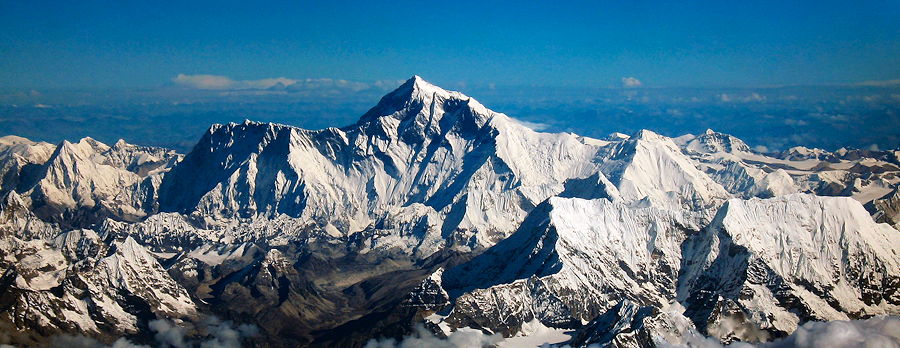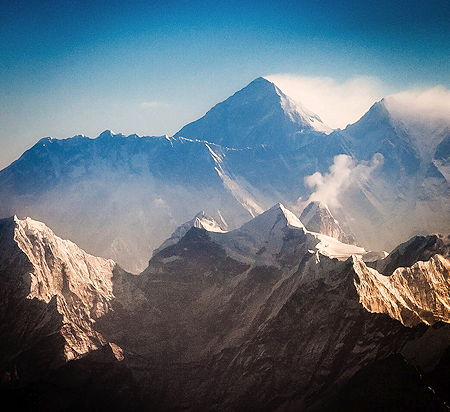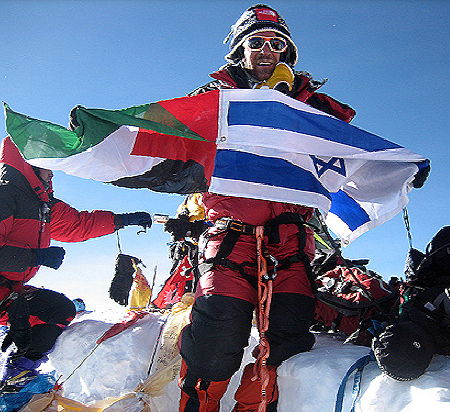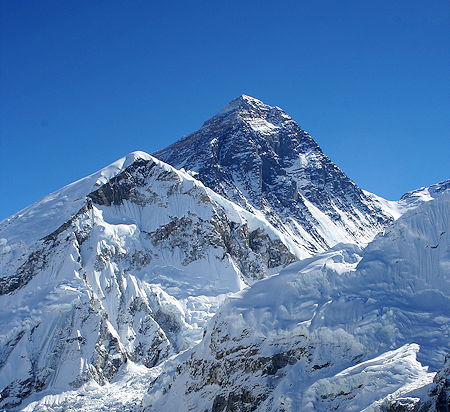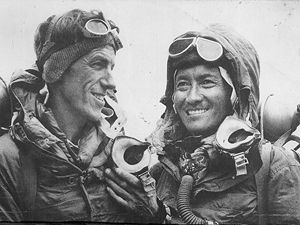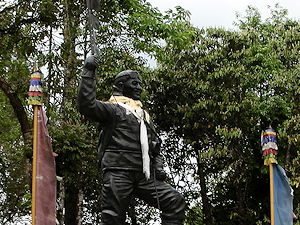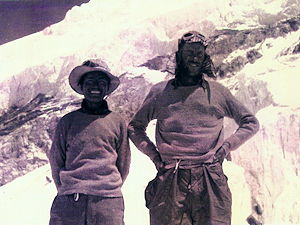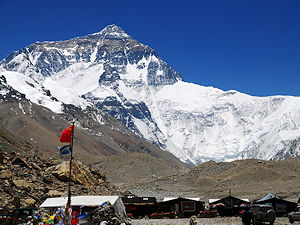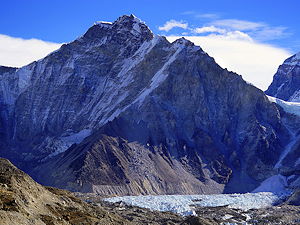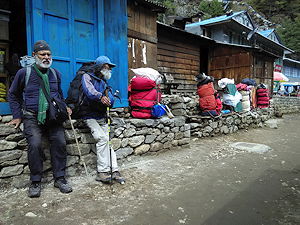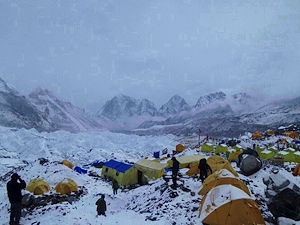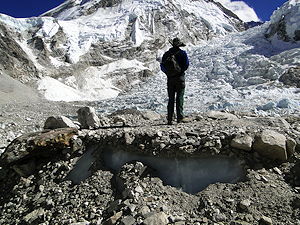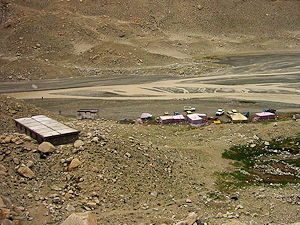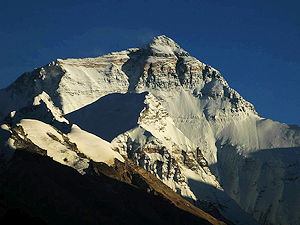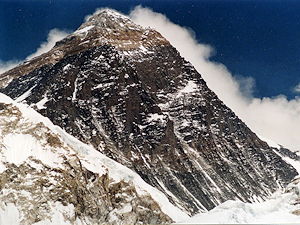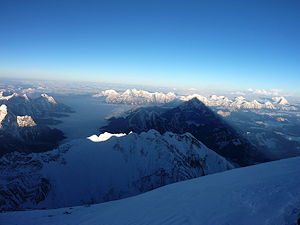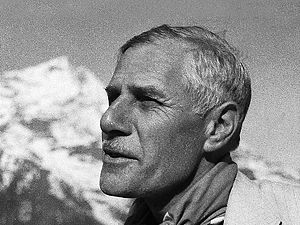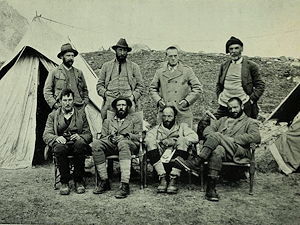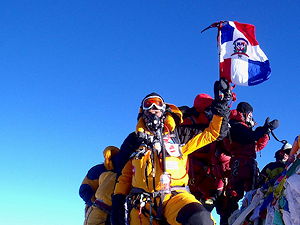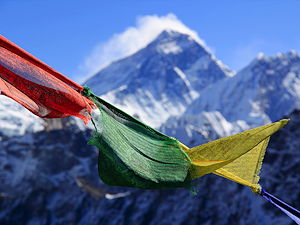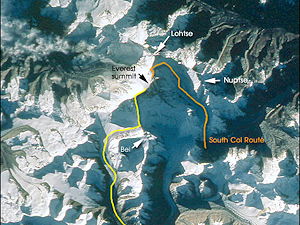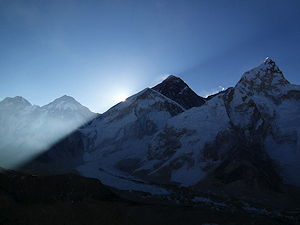Climbing Mount Everest, Nepal
At 8,848 metres, or 29,029 feet, Mount Everest is the tallest mountain in the world.
Everest has fascinated mountaineers since the British Great Trigonometrical Survey identified it as the world's highest peak in the mid-19th century. But, despite a number of well-prepared expeditions, it was not conquered for almost another century.
The mountain's attraction is easy to understand: Everest offers views over some of the most beautiful scenery on earth (for instance, the nearby peaks of Lhotse, Nuptse and Ama Dablam); it presents an enormous physical and mental challenge (humans were, after all, not designed to survive at over 8,000 metres, an altitude referred to by mountaineers as the 'death zone'); and allows those who summit it to say that they have - if only for a few minutes - been the highest person on earth.
But climbing Mount Everest has become increasingly controversial since the deaths of eight climbers on the mountain during a blizzard in May 1996, recounted in the book Into Thin Air and in the 2015 feature film Everest. The mountain is undoubtedly overcrowded in the 2-week weather window that opens up at the middle of each May. It has become polluted with oxygen bottles, litter, defecation and even dead bodies, especially at the higher camps. And a lack of regulation has permitted inexperienced climbers to attempt the climb, posing a danger to themselves and others.
This page contains information about Everest's history; Base Camp, Camps I to IV and Everest's summit; Everest's statistics and records; and practical information about climbing the world's highest peak.
1. First ascent
Initially called Peak XV, Everest was named after former British surveyor-general Sir George Everest.
Its Tibetan name is Chomolungma (roughly translated as goddess mother of the earth), and its Nepalese name is Sagamartha (meaning brow of the sky).
George Mallory may have been the first to ascend Everest, in June 1924, when he was seen 800 feet from the summit. But he perished soon afterwards and so it is not known whether he reached the top.
Mallory also uttered the most famous observation about the mountain: when asked in 1923 why he wanted to climb Everest, he retorted "because it's there".
The first ascent is instead attributed to New Zealander Sir Edmund Hillary and Sherpa Tenzing Norgay, who reached the summit simultaneously as part of a British-led expedition on 29 May 1953. News that the expedition, headed by Colonel John Hunt, had been successful arrived back in London in time to be released on the morning of Queen Elizabeth II's coronation four days later.
In May 1975, Junko Tabei became the first female to climb the mountain. Three years later Reinhold Messner and Peter Habeler were the first to achieve the summit without bottled oxygen. Messner, perhaps the most prolific mountaineer of all time, said that he would climb Everest "by fair means" or not at all. He repeated the feat from the Tibetan side in 1980, but this time without Habeler, chalking up the first solo ascent of Everest in the process.
2. Base Camp
Everest's summit is on the Nepal/China border, but the easier South Col route to the top travels through Nepalese terrain.
This route starts from the 5380-metre Everest Base Camp (see on map), reached by 6-8 day trek from Lukla airport (2860 m, also known as the Tenzing-Hillary Airport), itself a 40-minute flight by light plane from Kathmandu's Tribhuvan airport.
The usual route takes climbers to Phakding (2640 m, day 1), Namche Bazaar (3440 m, day 2, where an acclimatization day is advisable), Tengboche (3867 m, day 4), Dingboche (4260 m, day 5, where another acclimatization day is taken), Lobuche (4930 m, day 7) and Base Camp (5380 m, day 8).
Base Camp is no more than a basic campsite, with tents pitched on the rock and gravel that at this point cover the bottom reaches of the Khumbu Glacier.
During the peak climbing months - April and May each year - Base Camp turns into a tented city, bustling with Sherpas, porters, cooks and yaks organizing camping, climbing and communications equipment.
3. Camps I, II, III and IV
The easiest and most popular way to tackle Everest is via its southeast ridge, a climb that ascends the Khumbu Glacier and then the Western Cwm to the South Col before snaking roughly 90 degrees to the left to reach the summit.
It is traditionally tackled by establishing and then shuttling between four camps. Sherpas will do this to ensure that the higher camps are stocked with food, water and oxygen bottles. Clients attempting the summit will aim to gradually climb and then sleep at higher altitudes in order to acclimatise themselves to the thin air.
Camp I
The climb to Camp I (6,065 metres) from Base Camp involves crossing the hazardous Khumbu Icefalls, part of the Khumbu Glacier. Dangers include crevasses and shifting iceblocks the size of double-decker buses. For acclimatized climbers, the journey to Camp I takes 3-5 hours.
Jim Litch, a doctor at the Himalayan Rescue Association's Periche Clinic, has said that "Climbing through the Iceall is [as dangerous as] trying [repeatedly] to cross a busy interstate at night dressed in black clothes".
Climbing Sherpas find a route through the Icefalls at the beginning of each season, fixing ropes and 8-foot aluminum ladders with the assistance of one-metre long aluminum stakes. For particularly exposed sections, up to four ladders are bolted or lashed together to make bridges between iceblocks.
Once this has been done, each climbing team starts the task of finding and stocking the higher camps, to ensure that a summit push can be made when the weather allows.
Camp II
Camp II, at 6500 metres, is found at the base of the Lhotse face. The trip from Camp I involves a long and untechnical march through a silent snow valley, taking acclimatized climbers some 3-5 hours.
Also known as Advance Base Camp, Camp II is the place where climbers spend significant amounts of time acclimatizing to the altitude. When they have become accustomed to the thin air, climbers tend to climb directly from Base Camp to Camp II.
Camp III
Reaching Camp III, at 7470 metres, involves ascending the Western Cwm's snowfield. The 4-6 hour climb to starts off on easy snowy terrain but soon becomes more technical as steep ice is encountered.
Camp IV
Camp IV is found on the South Col, at an altitude of 7920 metres, on a broad saddle between Lhotse (8,516 metres) and Everest. Getting there requires climbers to cross two of the more technical parts of the route, the Geneva Spur and the Yellow Band. This leg will take acclimatised climbers c. 3-4 hours.
Camp IV's altitude places it in what has become known as the death zone, an altitude at which climbers can no longer acclimatize and instead deteriorate as a result of their inability to inhale sufficient oxygen.
For this reason, Camp IV is only used to store oxygen bottles and as a place to rest (most don't sleep) in the afternoon and evening before a summit attempt.
4. The Summit
The push to the summit from the South Col starts at about midnight, and takes those lucky enough to make it to the top between 10 and 12 hours.
Climbers generally arrive at the Balcony, at the bottom of the southeast ridge at around sunrise, and then follow that ridge to the top.
The most technical aspect is the Hillary Step, a 40-foot rock and ice wall at 8760 metres, to which ropes will have been fixed. This part of the route has become controversial over recent decades: the increase in inexperienced climbers attempting the mountain has meant that it has become a bottleneck, with novice climbers taking too long to clear the section.
In 2017, western climbers reported that the Hillary step had collapsed (presumably as a result of the 2015 earthquake). But their claim was contradicted by local Sherpas, who said that it was simply buried in snow.
Once the Hillary Step is safely negotiated, climbers are about an hour from the summit. They generally spend about 10-15 minutes there, before starting the return journey to Camp IV.
All being well climbers will return to Camp IV after 18 hours. They will spend the night there before returning to base camp the next day.
5. Records and statistics
How many people have climbed Mount Everest?
As of December 2017, 4,833 people have reached the summit of Mount Everest.
Many have scaled the mountain on more than one occasion. In total, there have been 8,306 ascents.
The record number of ascents, 24, is held by Kami Rita Sherpa. After his most recent attempt he quipped: "I can climb for a few more years. ... I am healthy - I can keep going until I am 60 years old. With oxygen it's no big deal."
The record number of ascents for a foreigner is held by British mountaineer Kenton Cool, who has summitted on 11 occasions.
The 13 year old American Jordan Romero is the youngest person to have reached the summit, with the 80 year old Yuichiro Miura from Japan being the oldest.
The summit has also been achieved by a number of people suffering from disabilities: blind climber Eik Wihenmayer summitted in 2001; and double amputees Mark Inglis and Sudarshan Gautam reached the top in 2006 and 2013 respectively.
In late 2017, the Nepalese government imposed restrictions requiring the disabled to have valid medical certificates before attempting to climb Everest.
How many people have died trying to climb Everest?
In total, 288 people have died climbing Mount Everest as of December 2017.
Avalanche casualties make up a significant proportion of this figure: 19 people perished in the April 2015 Nepal earthquake, which triggered a massive avalanche on Everest, and 16 died on 18 April 2014 following a serac collapse on the mountain's west shoulder. Avalanches in 2012 and 2013 claimed nine and four lives respectively.
Bad weather is another cause of death, with eight people dying when they became stuck high on the mountain during a blizzard on the mountain between 10-11 May 1996 (the subject of the book Into Thin Air and the 2015 feature film Everest).
Another danger stems from the number of people attempting to climb the mountain (72 summitted in 1990, a figure which had risen to 547 in 2012 and 658 in 2013). If there are only one or two good weather days in the May climbing season, this can result in hundreds of climbers attempting the summit on the same day.
Congestion increases the chances of rockfall or avalanche being triggered by other climbers, means that climbers have to clip out of fixed ropes to pass each other, and leads to bottlenecks on difficult parts of the route (in particular the Hillary step). On one occasion, a South Korean climber suffered snow blindness and hypothermia after waiting four hours for over 100 climbers to pass.
2019 Season
The 2019 season is proving to be especially deadly. As of 25 May 2019, ten climbers have perished on the mountain this year. This has led to intense criticism of the Nepalese authorities for issuing 381 permits for the spring season alone. Whilst the revenue (it costs $11,000 per permit) is no doubt necessary for the developing Nepalese economy, the typically short weather window means that there is overcrowding on the summit ridge. Various photographs have gone viral, showing traffic jams or "conga lines" of climbers.
What is the success rate for those attempting the climb?
In 1990, only 18% of those who attempted the climb reached Everest's summit. By 2012, that figure had risen to 56%.
2017 was a particularly good season: there were 648 summits and six deaths. The death rate of 1.15% is significantly less than the historical average of 3.3%.
The improvement is thought to be attributable to improved equipment, more precise weather forecasting and the experience that Western climbing companies in particular have gained.
6. Practical information
Those thinking of climbing Everest need to be extremely physically fit, to have a large amount of disposable income, and to have 2-3 months to travel to Nepal between March and May.
The route to the summit of Everest is not technically demanding. Were it not for the altitude, it could be completed by anyone with basic winter mountaineering and climbing skills. But the altitude means that the climb is extremely strenuous, even with the assistance of bottled oxygen, demanding a very high level of physical fitness.
Teams tend to reach base camp in early April, to give sufficient time to acclimatize before the mid-late May weather window opens. So you need to be able to take two months off work to attempt the ascent.
Western adventure companies such as Jagged Globe tend to charge about $65,000 for the Everest trip. Part of this will go on the peak fee of $11,000 imposed by the Nepalese government. Local operators charge much less, often in the region of $35,000.
Specialist equipment - such as down suits and sleeping bag rated to -20 degrees Celsius, mountaineering boots, and an oxygen mask and regulator - can easily add another $5,000 to $10,000 to the overall price tag.
Alan Arnette has written an excellent post on the cost of climbing Everest in 2017. He concludes that most people end up paying $45,000.
